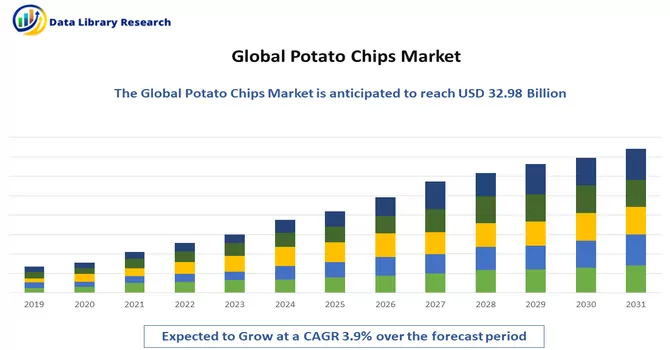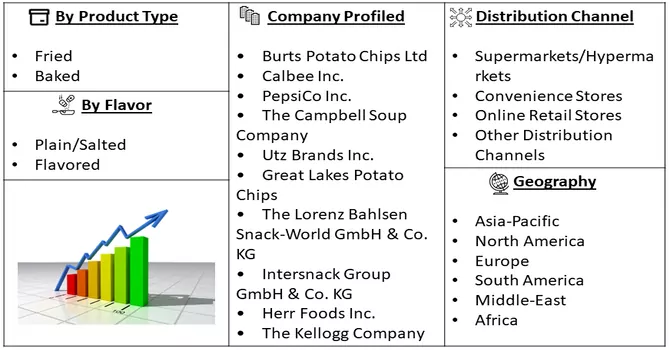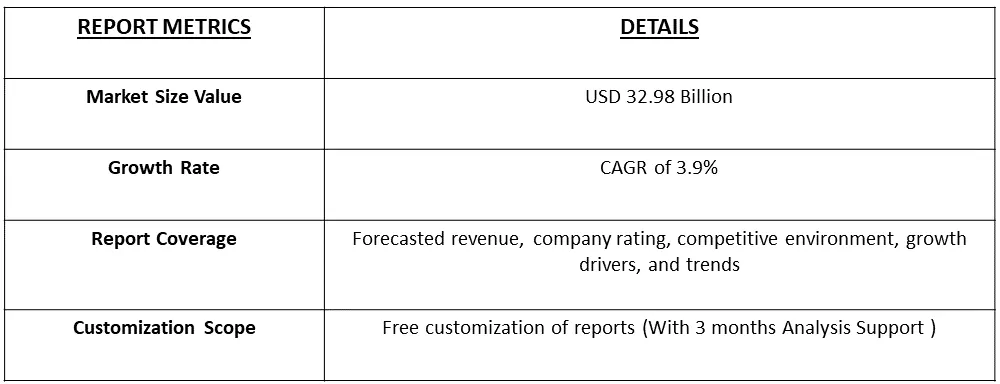The global potato chips market size reached USD 32.98 Billion in 2023 and is expected to register a growth rate (CAGR) of 3.9% during the forecast period 2024-2031.

Get Complete Analysis Of The Report - Download Free Sample PDF
Potato chips, also referred to as crisps in certain areas are thinly sliced potatoes that undergo deep-frying or baking until they achieve a crispiness. These slices are then seasoned with a variety of flavors like salt or spices. As a widely popular snack around the world, potato chips are recognized for their crunchy consistency and savory flavor, making them a universally loved and frequently indulged-in snack choice.
The potato chip market is driven by several key factors that contribute to its sustained growth and popularity. Firstly, the increasing demand for convenient and ready-to-eat snacks in busy lifestyles has propelled the market, as potato chips offer a quick and easily accessible snack option. Additionally, continuous innovation in flavors and healthier variants, such as baked chips, appeals to health-conscious consumers, broadening the market appeal. The global expansion of fast-food chains and the rise in on-the-go consumption further boost the market. Furthermore, effective marketing strategies, packaging innovations, and the introduction of regional and exotic flavors contribute to the overall expansion of the potato chip market, making it a dynamic and thriving segment in the snacks industry.
The potato chips market is witnessing several trends that shape its dynamics globally. Health-conscious consumer preferences are driving a surge in demand for healthier alternatives, leading to the introduction of baked, air-fried, or vegetable-based chips. The exploration of diverse and unique flavors, including exotic spices and regional inspirations, reflects the growing consumer interest in novel taste experiences. Sustainable and eco-friendly packaging solutions are gaining prominence as environmental concerns influence consumer choices, prompting manufacturers to adopt more responsible packaging practices. Additionally, the rise of premium and gourmet potato chip varieties, often positioned as artisanal or crafted, caters to consumers seeking elevated snacking experiences. The advent of online platforms for snack purchases and the increasing popularity of subscription boxes contribute to the changing landscape of how consumers access and discover new potato chip products, emphasizing convenience and variety in snack consumption trends. The potato chips market is experiencing robust growth driven by several key factors. Changing consumer lifestyles, marked by a preference for convenient and on-the-go snack options, contribute significantly to the increasing demand for potato chips.
Market Segmentation: The Global Potato Chips Market is Segmented by Product Type (Fried and Baked), Flavor (Plain/Salted and Flavored), Distribution Channel (Supermarkets/Hypermarkets, Convenience Stores, Online Retail Stores, and Other Distribution Channels), and Geography (North America, Europe, Asia-Pacific, South America, Middle East, and Africa). The report offers market size and values in USD million during the forecast period for the above segments.

For Detailed Market Segmentation - Download Free Sample PDF
Market Drivers:
Increasing Snacking Trends
The global chips market is significantly driven by the rising trend of snacking, as consumers increasingly seek convenient and on-the-go snack options. The demand for portable, flavorful, and ready-to-eat chips has surged, reflecting changing lifestyles and preferences. Evolving consumer lifestyles and hectic schedules have propelled the demand for quick, portable snacks, with chips being a favored choice. This trend is driven by a desire for convenience, making chips a go-to option for busy individuals seeking a tasty and easily accessible snacking solution.
Flavor Innovation and Diversity
The market is experiencing robust growth due to continuous innovation in chip flavors and diverse product offerings. Manufacturers are introducing unique and exotic flavor profiles, catering to diverse consumer tastes and preferences, thereby expanding the consumer base and fueling market growth. Ongoing advancements in flavor profiles and the introduction of diverse chip variants have become pivotal market drivers. With a focus on meeting varied consumer preferences, the industry is witnessing a surge in innovative chip flavors, ranging from regional specialties to exotic tastes. This dynamic flavor landscape not only attracts existing chip enthusiasts but also opens up new market segments, fostering sustained growth.
Market Restraints:
Health and Nutrition Concerns
Despite the market's growth, health and nutrition concerns pose a significant restraint. Increased awareness of the health implications associated with regular chip consumption, including concerns about high sodium and fat content, has led to a growing segment of health-conscious consumers seeking alternative, healthier snacks. The global chips market faces a restraint in the form of growing health consciousness among consumers. As awareness regarding the health impact of excessive sodium and fat consumption rises, a portion of the market seeks healthier alternatives. This shift in consumer preferences challenges the industry to address nutritional concerns and innovate with healthier chip options to sustain growth amidst an increasingly health-focused consumer base.
The COVID-19 pandemic has had a multifaceted impact on the potato chips market. Initially, during lockdowns and restrictions, there was a surge in demand for snack foods, including potato chips, as consumers stockpiled non-perishable items. However, as the economic uncertainties unfolded and lifestyle changes became more apparent, some consumers shifted towards healthier snacking options, impacting the traditional potato chips segment. Disruptions in the supply chain and manufacturing processes, along with fluctuations in raw material prices, posed challenges for the industry. Changes in consumer behavior, such as a preference for online shopping, influenced the distribution and marketing strategies of potato chip manufacturers. On the positive side, the resilient nature of snack foods as comfort items and the adaptability of the industry to changing circumstances played a role in mitigating the overall impact. The long-term effects on the potato chips market will depend on factors such as the pace of economic recovery, continued shifts in consumer preferences, and the ability of the industry to navigate ongoing challenges in the post-pandemic era.
Segmental Analysis:
Baked Chip Segment is Expected to Witness Significant Growth Over the Forecast Period
Baked potato chips have emerged as a popular and healthier alternative to traditional fried varieties, capturing the attention of health-conscious consumers. Characterized by a lighter texture and reduced fat content, these chips undergo a baking process that eliminates the need for deep-frying. The method preserves the natural goodness of potatoes while offering a satisfying crunch. Baked potato chips often feature diverse flavors, mirroring the innovation seen in traditional chips. With an emphasis on a guilt-free snacking experience, the market for baked potato chips continues to grow, appealing to those seeking a tasty compromise between flavor indulgence and mindful consumption.
Flavoured Segment is Expected to Witness Significant Growth Over the Forecast Period
Flavored chips have revolutionized the snacking landscape, offering a diverse and exciting array of taste experiences. This category of chips encompasses a wide range of bold and innovative flavor profiles, ranging from classic options like sour cream and onion to exotic blends inspired by global cuisines. The appeal lies in the ability to cater to diverse consumer preferences, keeping the snacking experience dynamic and engaging. Manufacturers continuously push the boundaries of creativity, introducing unique and unexpected flavor combinations that captivate taste buds. As a result, the flavored chips market thrives on its ability to provide a tantalizing journey of taste, making snacking an adventurous delight.
Hypermarket Segment is Expected to Witness Significant Growth Over the Forecast Period
Hypermarkets play a pivotal role in the retail landscape, offering consumers a one-stop shopping destination that includes a diverse array of products. Within the snack aisle, flavored chips have become a standout category. Hypermarkets stock an extensive selection of flavored chips, capitalizing on consumer demand for variety and taste innovation. The vast and well-organized spaces of hypermarkets allow for an expansive display of diverse chip flavors, from traditional favorites to unique and international-inspired options. This not only caters to the diverse preferences of shoppers but also provides a platform for new and emerging brands to showcase their innovative flavored chip offerings, creating a dynamic and engaging shopping experience.
Asia Pacific Region is Expected to Witness Significant Growth Over the Forecast Period
The chips market in the Asia Pacific region has witnessed remarkable growth, driven by a combination of evolving consumer preferences and a burgeoning snacking culture. As the population embraces busier lifestyles, there's a heightened demand for convenient, on-the-go snacks, making chips a go-to choice. The market thrives on the diversity of flavors, reflecting the rich culinary heritage of the region. From traditional options like salted and spicy flavors to more exotic choices inspired by regional cuisines, the array of offerings caters to a wide spectrum of tastes. The sheer size and diversity of the Asia Pacific market contribute to its dynamism. Rapid urbanization, rising disposable incomes, and an expanding middle class further fuel the demand for chips. Multinational and local players alike compete to capture market share by introducing innovative flavors and packaging strategies to appeal to the diverse consumer base. Moreover, the popularity of online retail channels has facilitated easier access to a variety of chips, contributing to market expansion. Convenience stores, supermarkets, and hypermarkets are key distribution channels, ensuring widespread availability. As the market continues to evolve, the Asia Pacific region remains a focal point for both established and emerging players in the global chips industry, presenting significant opportunities for growth and innovation.

Get Complete Analysis Of The Report - Download Free Sample PDF
The analyzed market exhibits a high degree of fragmentation, primarily attributable to the presence of numerous players operating on both a global and regional scale. The competitive landscape is characterized by a diverse array of companies, each contributing to the overall market dynamics. This fragmentation arises from the existence of specialized solution providers, established industry players, and emerging entrants, all vying for market share. The diversity in market participants is underscored by the adoption of various strategies aimed at expanding company presence. On a global scale, companies within the studied market are strategically positioning themselves through aggressive expansion initiatives. This often involves entering new geographical regions, targeting untapped markets, and establishing a robust global footprint. The pursuit of global expansion is driven by the recognition of diverse market opportunities and the desire to capitalize on emerging trends and demands across different regions. Simultaneously, at the regional level, companies are tailoring their approaches to align with local market dynamics. Regional players are leveraging their understanding of specific market nuances, regulatory environments, and consumer preferences to gain a competitive edge. This regional focus allows companies to cater to the unique needs of local clientele, fostering stronger market penetration. To navigate the complexities of the fragmented market, companies are implementing a range of strategies.
Some of the key market players are:
• Burts Potato Chips Ltd
• Calbee Inc.
• PepsiCo Inc.
• The Campbell Soup Company
• Utz Brands Inc.
• Great Lakes Potato Chips
• The Lorenz Bahlsen Snack-World GmbH & Co. KG
• Intersnack Group GmbH & Co. KG
• Herr Foods Inc.
• The Kellogg Company
Recent Development:
1) August 2022, Lays launched a premium potato chips range, Lays Gourmet. In addition to the launch, the company also unveiled a TVC film to promote and uniquely position its product among customers.
2) In May 2022, Walkers (United Kingdom) premium potato crisp brand sensations added a range of special flavors for Queen's jubilee. The flavors launched by the company included spit-roast pork and apple sauce and baked cheese and sweet honey.
Q1. What was the Potato Chips Market size in 2023?
As per Data Library Research the global potato chips market size reached USD 32.98 Billion in 2023.
Q2. At what CAGR is the Potato Chips market projected to grow within the forecast period?
Potato Chips market is expected to register a growth rate (CAGR) of 3.9% during the forecast period.
Q3. Which Region is expected to hold the highest Market share?
Asia Pacific region is expected to hold the highest Market share.
Q4. What segments are covered in the Potato Chips market Report?
By Product Type, Distribution Channel and Geography these segments are covered in the Potato Chips market Report.
Data Library Research are conducted by industry experts who offer insight on industry structure, market segmentations technology assessment and competitive landscape (CL), and penetration, as well as on emerging trends. Their analysis is based on primary interviews (~ 80%) and secondary research (~ 20%) as well as years of professional expertise in their respective industries. Adding to this, by analysing historical trends and current market positions, our analysts predict where the market will be headed for the next five years. Furthermore, the varying trends of segment & categories geographically presented are also studied and the estimated based on the primary & secondary research.
In this particular report from the supply side Data Library Research has conducted primary surveys (interviews) with the key level executives (VP, CEO’s, Marketing Director, Business Development Manager and SOFT) of the companies that active & prominent as well as the midsized organization
FIGURE 1: DLR RESEARH PROCESS

Extensive primary research was conducted to gain a deeper insight of the market and industry performance. The analysis is based on both primary and secondary research as well as years of professional expertise in the respective industries.
In addition to analysing current and historical trends, our analysts predict where the market is headed over the next five years.
It varies by segment for these categories geographically presented in the list of market tables. Speaking about this particular report we have conducted primary surveys (interviews) with the key level executives (VP, CEO’s, Marketing Director, Business Development Manager and many more) of the major players active in the market.
Secondary ResearchSecondary research was mainly used to collect and identify information useful for the extensive, technical, market-oriented, and Friend’s study of the Global Extra Neutral Alcohol. It was also used to obtain key information about major players, market classification and segmentation according to the industry trends, geographical markets, and developments related to the market and technology perspectives. For this study, analysts have gathered information from various credible sources, such as annual reports, sec filings, journals, white papers, SOFT presentations, and company web sites.
Market Size EstimationBoth, top-down and bottom-up approaches were used to estimate and validate the size of the Global market and to estimate the size of various other dependent submarkets in the overall Extra Neutral Alcohol. The key players in the market were identified through secondary research and their market contributions in the respective geographies were determined through primary and secondary research.
Forecast Model
